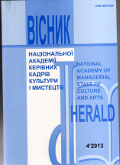Integrated design requirements for the cardboard and paper packing
DOI:
https://doi.org/10.32461/2226-3209.4.2013.138058Keywords:
integration processes, design concepts, information and communication elementsAbstract
The publication gives a comprehensive study of the phenomenon in relation to the integration of the design of products and packaging requirements for this type of product. The article discusses the importance of artistic and imaginative problems as the integrator and the state of relations between other components that affect the design process of packaging cardboard and paper and composite materials. The article shows the leading role of the arts- and artistic – project works in the creation of packages and in updating reporting system on goods that were made using these projects. Here we analyze scientific and journalistic materials on various aspects of the issue of designing packages. Such analyze allows to notice common thoughts of many scientists and researchers on the issue of large "compression" requirements for the design of cardboard and paper packaging and appropriate recognition of the integrated nature of the full range of packaging products. We consider the meaning and application of the scientific term "integrator" and its application to graphic design and packaging design directly. It is emphasized that the art-pattern problems are principal for the whole complex problem groups that exist in the process of designing packaging and play a role of an integrator. The use of the term integrator focuses on the specifics of the design. It cannot be considered as a simple summation of all the specified set of requirements. The project activity, by its very nature does not involve the use of "ready-made forms" and the universal "templates" for all design objects. Instead, it requires to make a choice in the direction to the optimal balance of all designated aspects and secure this balance in the forms of the design object. The conclusions were made about the integration processes in which integration does not play a role of a "mediator" between independent phenomena and processes, but makes these connections interpenetrative. In the future, this will affect the quality, efficiency and attractiveness of packaging products for different groups of potential consumers. The article examines the concepts of "imagery" as a set of tools that form an integral graphics solution that combines both visual and text elements. The design of the packaging industry encompasses, determines and maintains a collection of factors that do not fall within the exclusive form of decoration, but rather a combination of shapes, materials and design features is a significant factor in the formation of the outer packaging holistic vision of the future. Excessive cost of packaging that increases the cost of the packaged goods occupies a significant place among the material and constructive issues. The issue of innovation in creating an environmentally friendly packaging is touched on in the article. Their implementation and continued use in the consumer market is a priority for developers of innovative materials. Ecology today not only talks about the environment, but also about excessive information, so called the "visualinformation noise" that pollute social and spiritual space for active and passive consumers. The number of graphiccontent components plus the image, identity, brand names, and product names come into competition with each other. This problem reduces the effectiveness of the impact shaped packages. The axis of the integration is highlighted with respect to the packaging of products, based on discussed problem groups and the connections between them. The article gives the outline for the types of relationships between them.Downloads
Published
Issue
Section
License
Authors who publish with this journal agree to the following terms:
1. Authors retain copyright and grant the journal right of first publication with the work simultaneously licensed under a Creative Commons Attribution License International CC-BY that allows others to share the work with an acknowledgement of the work's authorship and initial publication in this journal.
2. Authors are able to enter into separate, additional contractual arrangements for the non-exclusive distribution of the journal's published version of the work (e.g., post it to an institutional repository or publish it in a book), with an acknowledgement of its initial publication in this journal.
3. Authors are permitted and encouraged to post their work online (e.g., in institutional repositories or on their website) prior to and during the submission process, as it can lead to productive exchanges, as well as earlier and greater citation of published work (See The Effect of Open Access).


